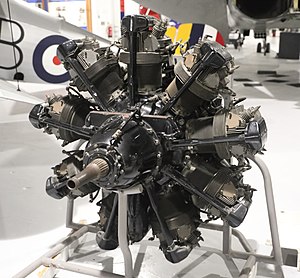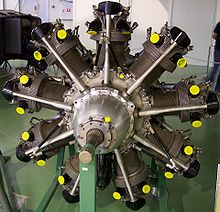
The Rolls-Royce Merlin is a British liquid-cooled V-12 piston aero engine of 27-litre capacity. Rolls-Royce designed the engine and first ran it in 1933 as a private venture. Initially known as the PV-12, it was later called Merlin following the company convention of naming its four-stroke piston aero engines after birds of prey. The engine benefitted from the racing experiences of precursor engines in the 1930s.
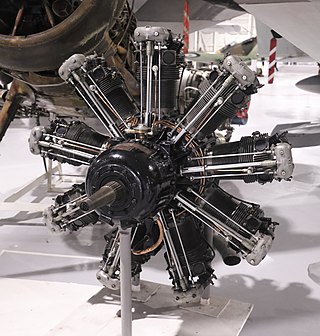
The Bristol Jupiter is a British nine-cylinder single-row piston radial engine that was built by the Bristol Aeroplane Company. Originally designed late in World War I and known as the Cosmos Jupiter, a lengthy series of upgrades and developments turned it into one of the finest engines of its era.

The Bristol Pegasus is a British nine-cylinder, single-row, air-cooled radial aero engine. Designed by Roy Fedden of the Bristol Aeroplane Company, it was used to power both civil and military aircraft of the 1930s and 1940s. Developed from the earlier Mercury and Jupiter engines, later variants could produce 1,000 horsepower from its capacity of 1,750 cubic inches by use of a geared supercharger.

The Bristol Perseus was a British nine-cylinder, single-row, air-cooled radial aircraft engine produced by the Bristol Engine Company starting in 1932. It was the first production sleeve valve aero engine.

The Napier Sabre is a British H-24-cylinder, liquid-cooled, sleeve valve, piston aero engine, designed by Major Frank Halford and built by D. Napier & Son during World War II. The engine evolved to become one of the most powerful inline piston aircraft engines in the world, developing from 2,200 hp (1,600 kW) in its earlier versions to 3,500 hp (2,600 kW) in late-model prototypes.

The Aquila was a nine-cylinder single-row radial aircraft engine designed by the Bristol Engine Company starting in 1934. A sleeve valve engine, its basic design was developed from the Bristol Perseus. The Aquila was never used in production, but further developments led to the Bristol Hercules, Bristol Taurus, and Bristol Centaurus.

The Taurus is a British 14-cylinder two-row radial aircraft engine, produced by the Bristol Engine Company starting in 1936. The Taurus was developed by adding cylinders to the existing single-row Aquila design and transforming it into a twin-row radial engine, creating a powerplant that produced just over 1,000 horsepower with very low weight.
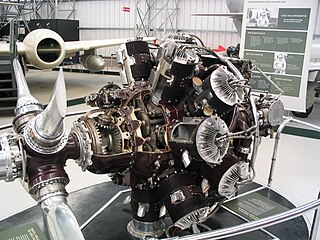
The Bristol Hercules is a 14-cylinder two-row radial aircraft engine designed by Sir Roy Fedden and produced by the Bristol Engine Company starting in 1939. It was the most numerous of their single sleeve valve designs, powering many aircraft in the mid-World War II timeframe.

The Centaurus was the final development of the Bristol Engine Company's series of sleeve valve radial aircraft engines. The Centaurus is an 18-cylinder, two-row design that eventually delivered over 3,000 hp (2,200 kW). The engine was introduced into service late in the Second World War and was one of the most powerful aircraft piston engines to see service.

The Rolls-Royce Peregrine was a 21-litre (1,300 cu in), 885-horsepower (660 kW) liquid-cooled V-12 aero engine designed and built by the British manufacturer Rolls-Royce in the late 1930s. It was essentially the ultimate development of the company's Kestrel engine, which had seen widespread use in military aircraft of the pre-war period.

The Rolls-Royce Kestrel is a 21.25 litre V-12 aircraft engine from Rolls-Royce. It was their first cast-block engine, and used as the pattern for most of their future piston-engine designs. Used during the interwar period, it was fitted to a number of British fighters and bombers of the era, including the Hawker Fury and Hawker Hart family, and the Handley Page Heyford. The Kestrel engine was also sold to international air force customers; in this role it was used to power prototypes of the German Messerschmitt Bf 109 and the Junkers Ju 87 "Stuka" dive-bomber, as the Junkers Jumo 210 engines were not ready to be fitted. Several examples of the Kestrel engine remain airworthy today.
Sir Alfred Hubert Roy Fedden MBE, FRAeS was an engineer who designed most of Bristol Engine Company's successful piston aircraft engine designs.

The Rolls-Royce Eagle Mk XXII is a British 24-cylinder, sleeve valve, H-block aero engine of 46 litre displacement. It was designed and built in the early-1940s by Rolls-Royce Limited and first ran in 1944. It was liquid-cooled, of flat H configuration with two crankshafts and was capable of 3,200 horsepower at 18 psi boost.
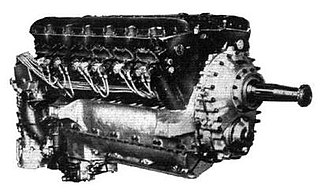
The Rolls-Royce Goshawk was a development of the Rolls-Royce Kestrel that used evaporative or steam cooling. In line with Rolls-Royce convention of naming piston engines after birds of prey, it was named after the goshawk.

The Armstrong Siddeley Jaguar is an aircraft engine developed by Armstrong Siddeley. The Jaguar was a petrol-fuelled air-cooled 14-cylinder two-row radial engine design. The Jaguar III was first used in 1923, followed in 1925 by the Jaguar IV and in 1927 by the Jaguar VI. In 1925 the Jaguar became the first production aero engine incorporating a geared supercharger.

The Gloster Gauntlet was a single-seat biplane fighter designed and produced by the British aeroplane manufacturer Gloster Aircraft in the 1930s. It was the last fighter to be operated by the Royal Air Force (RAF) to have an open cockpit, and also the penultimate biplane fighter in its service.
The Bristol Draco was an air-cooled nine-cylinder radial engine from the British manufacturer Bristol Aeroplane Company. It was essentially a version of their famous Pegasus converted to use a fuel injection system.

The Gloster SS.35 Gnatsnapper was a British naval biplane fighter design of the late 1920s. Two prototypes were built but the type did not enter production.

The Bristol Neptune was a seven-cylinder air-cooled radial engine developed in 1930. It had the same size cylinders as the earlier Mercury and Titan engines, 5.75 in (146 mm) x 6.5 in (165 mm) which gave a displacement of 1,182 cu in and produced a maximum of 320 horsepower (239 kW). The Neptune was effectively a seven-cylinder version of the Titan.
